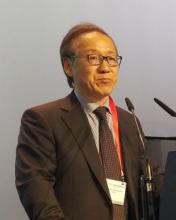BERLIN – The monoclonal antibody satralizumab reduced by 62% relapses of neuromyelitis optica spectrum disorder (NMOSD) over 24 weeks, as compared with placebo.
In the small phase 3 study, the IL-6 receptor blocker was even more effective in patients with high-risk aquaporin-4 antibodies, reducing relapses by 79%, compared with placebo, Takashi Yamamura, MD, said at the annual congress of the European Committee for Treatment and Research in Multiple Sclerosis.Chugai Pharmaceuticals of Tokyo and Roche are codeveloping the molecule. Called a “recycling” antibody, it has been designed to have extended circulation in plasma, Dr. Yamamura said.
The SAkuraSky study randomized 83 patients to placebo or to subcutaneous satralizumab 120 mg at baseline and weeks 2 and 4, and then once a month for 20 months.
Patients in the study had either aquaporin-4–positive NMOSD or neuromyelitis optica with or without aquaporin-4 antibodies. They also had to have experienced at least two relapses in the past 2 years, at least one of which occurred in the last year. The primary endpoint was time to first relapse during the randomized phase.
Patients were a mean of about 42 years old. A total of 64% were diagnosed with neuromyelitis optica and the remainder with NMOSD, with a mean disease duration of about 5 years. Aquaporin-4 antibodies were present in 67%. The baseline annualized relapse rate was 1.4. Baseline medications included azathioprine, mycophenolate, and oral corticosteroids. Patients stayed on these throughout the study.
Relapse curves separated significantly by 36 weeks, with 89% of treated patients being relapse-free vs. 66% of placebo patients. At 96 weeks, the curves still favored satralizumab, with 77.6% vs. 58.7% without relapse. The trajectories held steady until the end of follow-up at 216 weeks (relapse-free rates 60% vs. 30%; HR 0.38). The difference amounted to a risk reduction of 62%.
The antibody was even more effective for aquaporin-4–positive patients. By 48 weeks, the relapse-free rates were 91.5% vs. 60%. By week 96, 91.5% of treated patients were still without relapse compared to 53.3% of placebo patients. By week 216, those numbers were about 70% vs. 20%, for a 79% risk reduction. Treatment was still significantly better than placebo for aquaporin negative patients, but the benefit was less dramatic (67% vs. 56%; RR 34%).
The rate of serious infections was similar between placebo and satralizumab (62% vs. 68%) with no serious opportunistic infections in either group. Injection site reactions were more common among patients taking satralizumab (12% vs. 5%). Neoplasms occurred in 7% of each group.
Development of the molecule will continue, Dr. Yamamura said.
Chugai Pharmaceuticals sponsored the study. Dr. Yamamura has served as a consultant for the company and reported financial ties with numerous other drug manufacturers.
SOURCE: Yamamura T et al. ECTRIMS 2018, Oral abstract 323


